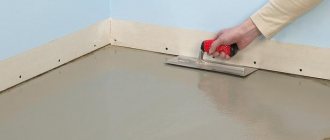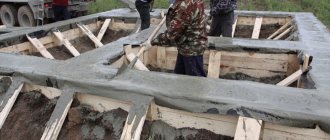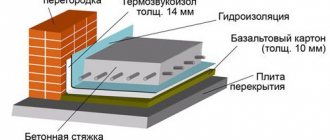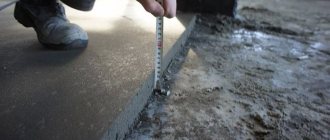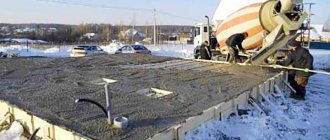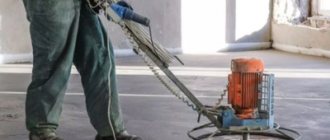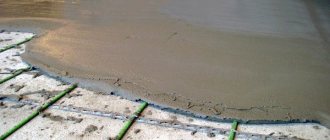The question of how long concrete takes to dry is of interest to any builder, since the duration of construction work depends on the time of setting and hardening of the mixture. Regardless of the type of object under construction, be it a temporary shed, a garage or a multi-story building, compliance with the hardening time allows you to create a structure that has standard strength parameters. If you know the exact curing time, you can competently plan construction processes and effectively optimize the construction time of buildings.
Stages of drying concrete mortar
Hardening of the solution occurs due to hydration, that is, a reaction that, after pouring, begins to occur between water and the binder components of the mixture. The essence of the chemical process is to convert the constituents of concrete into calcium hydrosilicate, which, after final drying, forms a monolithic base with high strength parameters.
To determine the time for complete hardening of concrete, it is important to understand that all reactions that occur in the composition are conditionally divided into two stages:
- Setting
occurs approximately an hour after mixing. During this period, the elements of the solution react, and the mixture itself begins to lose its mobile and plastic properties. - Hardening
- implies crystallization of the solution with a branded set of rigidity and strength. Hardening times depend on weather conditions, proportions and quality of the solution components.
Stages of concrete strength development
Essentially, there are only 2 stages:
Setting of concrete occurs after a couple of hours. By eye you may notice that the composition becomes less mobile. The process ends after an hour, after which the strength gain begins. In some cases, the setting time of concrete can be extended. This often happens due to mixing too long/fast.
The time for concrete to gain strength can last up to a year. This depends on the environment as well as the composition.
How long does it take for concrete to set?
The setting stage of the solution lasts a short time. On average, for the most popular brands (M200, M300) it does not exceed 1 hour at a temperature of +20°C. If the temperature is lower, the time increases to 4–5 hours, and in hot weather, coupling may take no more than 20–30 minutes.
Builders need to take into account the hardening time of concrete, since the finished solution very quickly loses its plasticity. To avoid possible problems in the future, use the prepared mixture immediately after mixing. Often it is delivered to the construction site ready-made in special concrete mixers, which do not stop mixing even during transportation.
Hardening time of concrete in formwork
The formwork limits the mobility of the composition, for this reason the speed of processes in it occurs faster. According to GOST, it can be removed when the concrete reaches 70% of its design strength, i.e. in about 7 days.
If durable concrete is not needed, for example, when building a barn or garage, the formwork can be removed after 3-4 days.
Hardening processes
Hardening is a longer process, lasting on average up to 28 days. Immediately after setting, the solution still remains soft, but already becomes immobile. Gradually it undergoes crystallization and acquires the necessary rigidity indicators. The strength gain is determined according to the graph or using the formula:
Rn = R28(lgn/lg28), where:
- Rn – solution strength;
- n – time that has passed since pouring the mixture (in days);
- R28 – brand of building material.
Strength parameters are determined only from the third day from the moment of mixing. When figuring out how long concrete hardens, special attention is paid to the 7th and 28th days. On average, after 14 days from filling, Rn reaches 70%.
Dependence of foundation holding time on its type
Insinuations that the finished foundation, after the concrete components included in it have reached the normalized strength, should stand for a year or winter are absolutely unfounded. A common misconception about the need to withstand the structure until the end of the ongoing sedimentation-shrinkage processes arose as a result of the substitution of concepts. A fully erected building must be conditioned before finishing finishing begins. This is explained simply by the example of existing varieties of structural foundations.
Video on how to speed up concrete hardening
Columnar foundations
A columnar foundation is a series of individual pillars, for the construction of which brick or stone masonry is used; often the foundation pillars are made of concrete or reinforced concrete. To give the foundation elements additional stability, a grillage is installed - a reinforced concrete strip connecting the head of the pillars.
This type of foundation is classified as a light variety, therefore, the foundation base, not loaded with the weight of the building, is subject to increased mobility during soil movements with heterogeneous morphology, and can be easily deformed as a result of frost heaving. By definition, the foundation of a columnar structure cannot stand, and the construction of walls must begin immediately after the masonry mortar has set or the concrete has gained strength.
Strip foundations
Strip reinforced concrete foundations can be constructed in two types:
- shallow foundations are equipped for the construction of light buildings and their soles rest on soil horizons located above the freezing level;
- deeply buried options involve the construction of voluminous structures with a large weight on them; the level of their base exceeds the depth of soil freezing.
A shallow strip foundation experiences loads that are similar in tension and strength to the impact on columnar versions with a grillage. If such a foundation is allowed to stand for a period when active soil heaving occurs under the influence of freezing and thawing of ground moisture, the possibility of its deformation is very likely.
Deep strip foundations rest their base on dense horizons and are not affected by ground shifts. Shrinkage processes in the concrete mass are completely completed after reaching the standard strength, and the settlement of the structure under the influence of its own mass, without taking into account the weight of the building, is completely leveled by expansion joints.
Slab varieties
Monolithic foundations are simply calculated and arranged; they provide a foundation for the building under construction with sufficient strength characteristics. The uniform distribution of the load on the soil base due to the large supporting surface determines the minimum value of the specific pressure on the soil. A properly prepared sand or sand-crushed stone cushion under the foundation slab can prevent its significant sedimentary movements.
The stability of the building being built on a slab foundation directly depends on how carefully the preliminary excavation work was carried out. The amount of time a monolithic foundation must stand is determined, again, only by the period necessary for the concrete to gain strength.
Pile foundations
The foundations of buildings on piles, with any technology of their arrangement, ensure the transfer of load to deep, often bedrock, horizons of soils and rocks. This type of foundation construction completely eliminates the possibility of building deformation, regardless of how much time is allocated for them to stand after installation is completed.
Determining the time for how long the foundation should stand after pouring should be correlated with the time period during which ready-mixed concrete will gain the strength standardized by SP 70.13330.2012. Additional curing is not advisable, and in cases of using columnar structures and shallow strip foundations, it is even contraindicated.
Temperature
The optimal temperature for drying the solution is +20…+22°C. The higher it is, the faster the mixture sets and hardens. If the thermometer reads 0°C or below, hydration stops. In such a situation, builders have to use artificial hardening methods, for example, adding potassium chloride or turning on heat guns. In extreme heat, it is necessary to increase the humidity of the concrete, otherwise the moisture from the mixture will quickly evaporate and, as a result, a chemical reaction will not begin.
To figure out how long it takes for a concrete screed to dry outside at different temperatures, check out the table.
| Solution temperature, °C | Hardening time, days | ||||
| 3 | 5 | 7 | 14 | 28 | |
| 50 | 70 | 84 | 95 | – | – |
| 40 | 64 | 75 | 85 | – | – |
| 30 | 57 | 68 | 76 | 95 | – |
| 20 | 50 | 60 | 69 | 87 | – |
| 10 | 42 | 51 | 59 | 75 | 91 |
| 0 | 31 | 39 | 46 | 61 | 77 |
Design requirements
The concrete blind area has a fairly simple design, the preparation of which will require the following materials:
- Bedding (pillow). This is done before pouring the solution. A variety of materials are used as backfill: coarse or medium sand, sand-gravel mixture, crushed stone, fine gravel. The foundation area cannot be laid on fine sand due to the possibility of shrinkage, since in this case there is a risk that the base will crack. It is best to prepare a two-layer cushion: first lay gravel or crushed stone, which will compact the soil, and then sand.
- Reinforcement. The presence of reinforcing mesh for a concrete blind area will give the structure more strength. The cell size of this product is usually 30 x 30 or 50 x 50 cm. The mesh diameter should be about 6-8 mm, but it all depends on the type of soil.
- Formwork. Wooden guides located along the perimeter of the coating are required, as they will prevent the concrete mixture from spreading. The width of the formwork boards is usually 20-25 mm.
- Concrete solution. The blind area is poured using a specific concrete mixture composition.
Concrete classes, depending on the strength of the composition
. To obtain a high-quality coating, it is most profitable to make a concrete mixture on your own.
To fill the blind area of a house with concrete, you need to familiarize yourself with the regulations and recommendations of SNiP:
- The width of the blind area should be 20 cm greater than the roof overhang (SNiP 2.02.01-83). If the structure has a drainage system, then its indicators are also taken into account. The optimal value is 1 meter. In this case, you can lay a tile path around the house.
- The length of the blind area around the house, made with your own hands, must correspond to the perimeter of the building. However, if you plan to install a concrete porch, then a “break” is allowed.
- Depth. The depth of the “tape” is half the calculated freezing depth of the ground.
- The thickness of the concrete blind area is also regulated by SNiP and, according to these requirements, should be at least 7-10 cm for the top layer. However, many people make concrete parking spaces for personal cars along with the blind area. In this case, the operational load increases, and the thickness of the concrete blind area can reach up to 15 cm.
The blind area must be built at a slope of 2-3 degrees
- Slope. According to SNiP III-10-75, the slope should be from 1 to 10 cm for each meter of width. Most often it is 2-3 cm per meter - this is approximately 2-3 degrees. The angle of inclination must be directed in the direction opposite to the foundation. It is not recommended to increase the slope, since in this case it will be difficult to walk along such a path in winter, when ice forms on the surface.
- Border. The installation of a blind area for a house does not include the mandatory production of a border, so in this case the decision is made by the owners of country property. However, experts recommend installing such “limiters” if trees and shrubs with an “aggressive” root system (blackberries, raspberries, plane trees, poplars and others) grow near the foundation.
- Base height. For a hard type covering (concrete), the base must be at least 50 cm.
- The recommended height of the blind area above ground level is 5 cm or more.
There are also several schemes according to which a blind area can be built from crushed stone, in the form of a monolithic concrete covering, both for normal soil types and for “problematic” ones.
Types of blind area, based on soil characteristics
Knowing the requirements of SNiP and the features of a suburban area, you can make a blind area with your own hands using the step-by-step instructions given below.
Concrete grade
The process of setting and hardening is largely influenced by the components of the mixture and their proportions. In particular, the more porous materials in the solution, the slower the evaporation of moisture will be. The main factor in the hydration time is the grade of concrete. The lower it is, the less intense the strength gain of the building material. Although heavier grades harden faster, in any case it is recommended to keep the finished solution for at least 28 days before loading.
Let's look at how long it takes for the most popular brands of concrete to harden.
| Brand | Brand strength, % | Maximum strength, kgf/cm² | Curing time, days |
| M400 | 100 | 196,45 | 25 |
| M300 | 60 | 360,18 | 14 |
| M200 | 30 | 392,9 | 3 |
Daily schedule
Below is a graph of how concrete gains strength daily depending on temperature. It shows that in summer, when the air warms up to 25-35°C, the ripening time is reduced to 16-20 days. Please note that the concrete strength gain and hardening schedule does not take into account humidity.
If you are doing construction in winter, you will have to create artificial conditions for hardening.
For example, cover the formwork with reflective film and install infrared heaters. The use of wind blowers and fan heaters is not recommended, because they dry out the air and can cause cracks.
What does a violation of exposure time lead to?
Builders are advised to fully maintain the drying time of the mortar. If you put stress on it ahead of schedule, this can lead to a number of problems in the future:
- The appearance of cracks
- this is especially true for the foundations of buildings, which can be subject to fracture along the entire height. Often cracks appear not only in the foundation, but also in the ceilings or walls, and they are often through. To avoid troubles with the foundation, it is important to know how long concrete hardens in the ground. As a rule, the formwork is removed no less than 2 weeks after it is poured, otherwise the structure may be damaged. - Deformation
– common problems associated with insufficient concrete curing time include deformation processes in the foundation, cracking of the floor screed, and the formation of chips or dents on the walls. - Damage to finishing
- occurs after interior or exterior finishing work. For example, if a house was built from unseasoned aerated concrete, then plaster may fall off the walls or wallpaper may peel off. If the floor screed in the bathroom does not have enough time to harden, ceramic tiles may subsequently peel off from it.
Factors negatively affecting concrete hardening
Shocks and vibrations in the initial period of its hardening also lead to deterioration in the quality of the structure - they disrupt the newly created structure.
In order for concrete to gain the required quality and strength, it needs proper care. It is necessary to maintain the hardening temperature regime, prevent the occurrence of temperature-shrinkage deformations and cracks, and protect the hardening structure from mechanical influences.
Failure to comply with concrete hardening conditions can lead to a low-quality structure and sometimes to its destruction. This can also happen if high-quality concrete is laid and all concrete, reinforcement and formwork work is carried out correctly. It is especially important to care for hardening concrete during the first days after laying.
How to speed up the drying of the mixture
If construction deadlines are tight, that is, it is not possible to wait for final hardening or it is not possible to ensure optimal humidity and temperature, it is permissible to use methods that help speed up hardening. These include:
- heating the solution at low air temperatures (steam, electricity, etc.);
- the use of additives to accelerate hardening;
- laying polyethylene on the surface, which retains the heat generated during hydration.
Carrying out construction work using concrete requires a special approach at each stage. If you approach the drying time of the mixture correctly, you can achieve increased strength of the building and avoid troubles associated with its deformation due to insufficient curing.
Author of the article
Methods for regulating the rate of concrete hardening
So, the hardening and drying time of concrete can be adjusted - and in both directions. This allows you to either reduce the time for construction work or move it to another time.
Acceleration of hardening
There are 3 ways to do this:
Also, do not forget that the hardening of concrete varies depending on temperature. Filling in summer will harden 1.5 times faster than in autumn or spring.
You can speed up hardening in winter using the following methods:
Hardening slowdown
Slowing down is only possible with the help of special additives. This can be useful if the composition needs to be transferred to another location or during multi-stage filling.
You can also slow down the hydration process by increasing the proportion of water in the composition. You shouldn't do this, because... the quality of concrete may deteriorate, and in winter it may even lead to crystallization and cracks.
Control of concrete strength gain
Various instruments are used to measure the characteristics of a mixture. They allow you to determine how the foundation will withstand loads in the future. The calculation determines the maximum permissible loads that the material can withstand without breaking its structure.
There are 2 ways to control quality:
The first case involves a test on a finished foundation.
The second is the creation of several cubes that freeze together with the monolith. After this, the cubes are tested on a hydraulic press.
To assess strength, special instruments are used:
Table
The strength gain of concrete over the course of a day occurs non-linearly. It is most intense in the first 5 days, when hydration reaches 50%. Then the process gradually fades away.
Below is a table of concrete strength in MPA for classes 200 and 300. Unlike the graph, here you can see the hardness of the composition in percentage terms.
Source
The construction of structures of various configurations and purposes involves pouring a foundation. Therefore, many builders, mainly beginners, are interested in what is the time for concrete to gain strength. It is immediately worth noting that this process depends on numerous factors, including not only environmental conditions, but also the components of the solution itself used to fill the foundation.
In this article we will try to figure out how concrete gains strength and whether there are methods to speed up this process.



